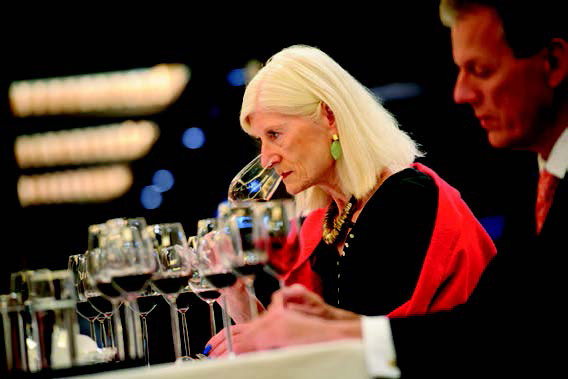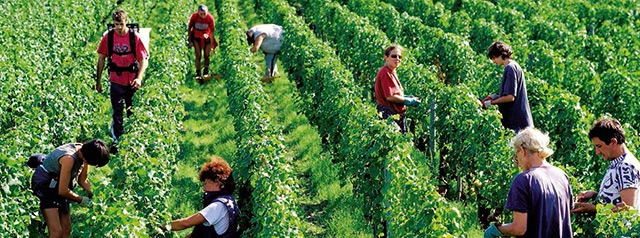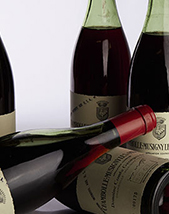Wine Futures: A Guide to Buying
The Vine | By Sotheby's Wine | 06 Apr 2018
Every Spring, the Sotheby's Wine team travels to Bordeaux to taste the most recent Futures. This helpful guide presents all the facts to help you start your wine collection or purchase this year's crop.

PHOTOGRAPHY © F. POINCET
What are Futures?
Buying Futures - also know as en primeur - means purchasing wine that is still maturing in the barrel and has not yet been bottled.
The top chateaux in Bordeaux offer the majority of their wines (approximately 80-90%) for sale as Futures in the spring following the harvest. As a result, this is the first opportunity to purchase the new vintage. Bordeaux is the most important wine that is traded as a Future, but some othe regions and producers also make their wines available.
Why buy Futures?
The advantage of buying Futures are:
- To Purchase wine at the first release price, when the margins made by wine merchants are the smallest. In most vintages, although not always the case, the price of the wine increases and the margins made by the wine merchants also increase once the wine is offered for sale in bottle.
- To secure allocations of hard to find wines and varying formats (half bottles, magnums, double magnums, imperials and even larger) as soon as they are available for purchase.
- To ensure perfect provenance by owning the wine from its first release.
- To secure wine for a special birth year - as a gift for children, grandchildren, godchildren or for weddings and anniversaries.
- To purchase the latest vintage of wines that you like to buy every year and where there is generally strong demand, such as Lafite, Mouton Rothschild, Margaux, Haut Brion, La Mission Haut Brion, Cheval Blanc, Petrus, Lynch Bages, Montrose, Pichon Lalande, Ponet Canet and Haut Bailly.
- When selling wines, ownership since initial release can bring higher prices.

Who buys Futures?
Price, provenance and access are the biggest benefits in buying Futures and this attracts all wine enthusiasts, from private collectors who intend to drink their wines, to collectors who invest in wines, as well as wine funds.
Futures Timeline
Year of the Vintage
Vines Pruned: The canes from last year's vines are removed by hand in mid-winter. The vines are dormant over the winter, preserving their energy for the growing season to come.
Vines Flowering: In May or June, the vines flower. In an ideal growing season, the sugars and flavor compounds in the grapes develop gradually over the course of a warm, dry summer.
Harvest: Starting at the beginning of September, and often running through mid-October, the harvest takes place. Fine weather is crucial at this point, since any rain can dilute the vintage. Even after indifferent summer weather, vintages have been saved by a dry September and October.

SOTHEBY'S SERENA SUTCLIFFE, MW, TASTING WINE.
Year after the Vintage
Wine Tasted: After the wine has been in barrel for about 3 or 4 months, an army of wine professionals arrive from around the world to taste the new vintage. Sotheby's Serena Sutcliffe and Jamie Ritchie are among them, and they taste hundreds of wines, noting their opinions and scores on the young wines.
Aging Barrels: Once fermentation is over, the young wine is carefully transferred to small, new oak barrels, which will be its home for the next two years. Here the wine gradually softens and all of its components - acidity, tannins and flavor compounds - become a seamless whole.
Second Year after the Vintage
Futures Offered for Sale: Shortly after the wines have been tasted, the chateau owners release the prices of the new vintages which can happen from April through June.
Third Year after the Vintage
Wines Shipped and Delivered.

When can I drink my Futures?
Here is a general guide, although each wine from each vintage may vary.
Petits Chateaux: 3-10 years
Crus Bourgeois: 5-15 years
Second Wines from top chateaux: 5-15 years
Second to Fifth Growths: 10-30 years
Super Seconds and First Growths: 15-20 years
If I want to invest in wine, what are the drivers of the market?
In the last fifteen years, there has been a significant change in the price of wine and the underlying factors affecting the market, represented by two main points:
-Demographic change: As significant wealth has been created by a much younger generation (e.g., technology and finance), the average age of the wine auction buyer has fallen from being approximately 60 years old to roughly 40 years old.
-Geographic change: Demand for fine wines continues to grow in North America and the traditional wine buying countries in Europe, but now there is also significant demand throughout Asia, South America and Russia.
If you believe that more people from more countries and from a wider age group will want to buy great wines, then the price of fine wine will have to rise, as production of top class "collectible" wine is limited to only one new vintage every year, and most wineries are focused on increasing quality, thereby potentially reducing quantity.
.jpg)
PHOTOGRAPH © F. POINCET
Sign up for Sotheby's Futures emails
Let us know which wines you are interested to buy by signing up for our email lists, or contact us with any questions:
wine@sothebys.com
New York: +1 212 894 1990
London: +44 20 7293 5050
Hong Kong: +852 2822 8157
Learn more about Sotheby's Wine, available for purchase online or at our retail locations in New York and Hong Kong.
By using this site, you agree to our updated Privacy Policy and Cookie Policy.





